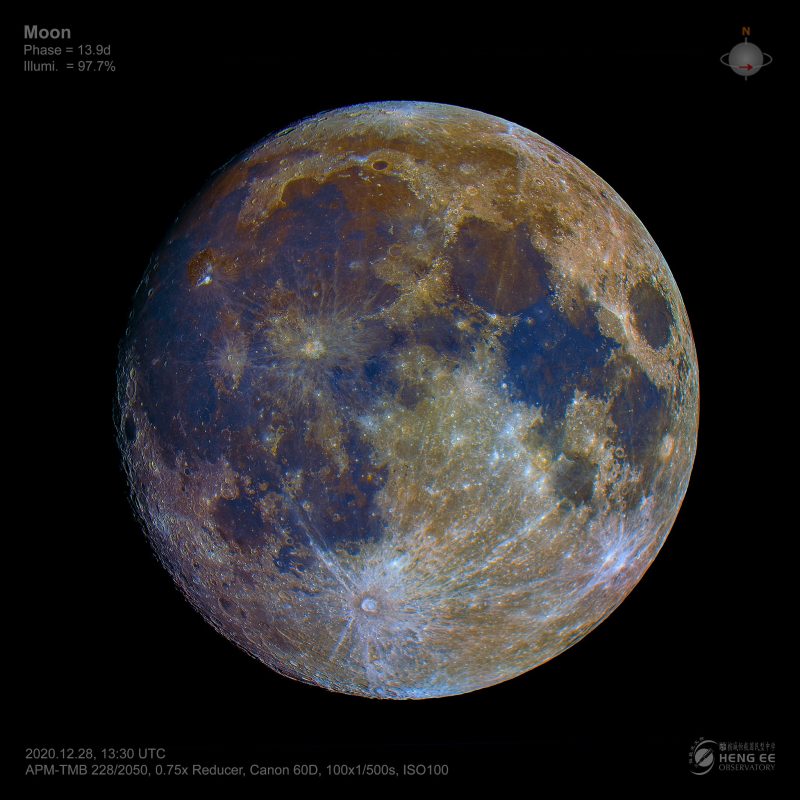Above: Manish Mamtani captured the full Cold Moon over Maine’s Nubble Lighthouse, which was lit up for the holiday season in 2019. Many called this full moon the last of the decade. View at EarthSky Community Photos.
To many, the last full moon of the decade came last year, on December 12, 2019. But purists will call the December 2020 full moon the last full moon of the decade. It happens on December 29 or 30, depending on your time zone (more full for the Americas on the night of December 29; round and full on December 30, too, for everywhere worldwide). Like every full moon, December’s full moon has its own special characteristics. And like every full moon, it carries a name. At northerly latitudes, we call the December full moon the Cold Moon or Long Night Moon. It shines in the sky from dusk to dawn, like a wonderful nocturnal sun, giving us a much-appreciated reprieve in the season of diminished daylight.
The moon reaches the crest of its full phase on December 30, 2020, at 03:28 UTC (translate UTC to your time). Yet, for the United States, the moon turns precisely full on December 29, at 10:28 p.m. EST, 9:28 p.m. CST, 8:28 p.m. MST, 7:28 p.m. PST, 6:28 p.m. Alaskan Time and 5:28 p.m. Hawaiian Time.
Keep reading to learn more about decades and about December’s full moon.
EarthSky lunar calendars are available now! Order today. Going fast!

Far-southern December sun means far-northern December full moon
In December, from around the world, the sun rises and sets farthest south of due east and west for the year. For the Northern Hemisphere, these far-southern sunrises and sunsets bring short days and long nights; and in the Southern Hemisphere, these far-southern sunrises and sunsets accompany long days and short nights.
North of the Arctic Circle, the sun neither rises nor sets, because the far-southern sun stays below the horizon at these far northern latitudes. However, since the full moon lies opposite the sun, the December full moon mimics the position of the far-northern June sun. So, north of the Arctic Circle, this December full moon playacts as the June midnight sun.
South of the Antarctic Circle, the far-southern December sun neither rises nor sets, as well, except that the sun stays above the horizon for 24 hours around the clock. But, then, at these far-southern latitudes, the December full moon stays beneath the horizon, like the sun in June.
Yes, the full moon assumes the sun’s position for six months hence. This December full moon shines in front of the constellation Gemini the Twins, or where you’ll find the sun six months later. Despite the short days and long nights of December that must be endured at our northerly latitudes, the December full moon reminds us that the long days of June will prevail once again.
Visit Heavens-Above to see the moon’s present position on the zodiac.

Although it’s somewhat arbitrary, most people regarded the full moon of December 12, 2019, as the last full moon of the decade (2010 to 2019). Purists insist, however, that the full moon of December 30, 2020, counts as the last full moon of the decade, and that 2020, not 2019, ends the second decade of the 21st century, with the 21st century being defined as 2001-2100.
First decade of the 21st century (2001 to 2010)
Second decade of the 21st century (2011 to 2020)
Here’s what Wikipedia has to say about decades:
An ordinal decade in the Anno Domini year numbering system is a period from a year which ends on the digit 1 to the following year which is a multiple of ten; for example, the period from 1961 to 1970 was the 7th decade of the 20th century (or the 197th decade), and the period from 2001 to 2010 was the 1st decade of the 21st century (or the 201st decade).
Also from Wikipedia:
There is currently an ongoing argument whether the ‘new decade’ begins on January 1, 2020, or January 1, 2021. According to the widely-used Gregorian calender, the 203rd decade will begin on January 1, 2021, as the first year is the year 1, not zero.
Astronomically speaking, the moon turns full at the instant that it is 180 degrees opposite the sun in ecliptic longitude. In other words, the elongation between the moon and sun equals 180 degrees. Visit Unitarium.com to know the present moon-sun elongation, remembering that a positive number means a waxing moon moon and a negative number a waning moon.
Bottom line: We in North America often call the December full moon the Cold Moon or Long Night Moon. Some people will also regard this December full moon as the last of 124 full moons in the 202nd decade (January 1, 2011 to December 31, 2020).











